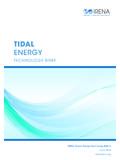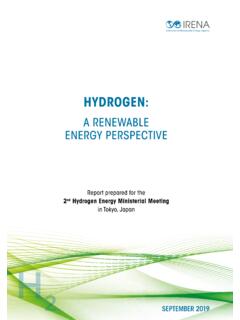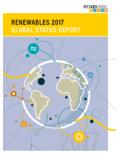Transcription of The South African Renewable Energy Independent …
1 The South African Renewable Energy Independent power producers procurement programme (REIPPPP) Lessons Learned 17 March 2016. it (REIPPPP) has already established a flagship public-private partnership model for South Africa, and indeed the rest of Africa, and in the process is helping alleviate Eskom's current power crisis while also reducing greenhouse gas emissions.. - Enabling Renewable Energy in South Africa: Assessing the REIPPPP, WWF, August 2014. Outline Context of South Africa Key design features of REIPPPP. Outcome of the first bid windows programme successes IPPPP key challenges and lessons learnt 2. OVERVIEW OF THE programme &.
2 procurement APPROACH. 3. Context for the IPPP programme NDP IRP Determinations IPPPP. The National The Integrated Resource In May 2011, the DoE The Independent power Development Plan (NDP) Plan (IRP) 2010 gazetted the New Producer procurement identifies the need for developed the preferred Generation Regulations programme (IPPPP) is a South Africa to invest in Energy mix with which under the Electricity key vehicle for securing a strong network of to meet the electricity Regulation Act (ERA) and electricity economic infrastructure. needs over a 20 year made the following capacity planning horizon to determinations: from Energy infrastructure is 2030.
3 13 225 MW RE the a critical component. 2 500 MW designated from private coal-fired plants Sector for The NDP requires the 1 800 MW of cogeneration Renewable development of under the MTRM plan 3 126 MW of Gas-fired and non- Renewable 10 000 MWs additional power plants Energy sources as electricity capacity to be (2 652 MW base load + determined by the established by 2025 474 MW MTRM) Minister of Energy . against the 2013 2 609 MW of imported baseline of 44 000 MWs. hydro 4. Integrated Resources Plan 5. Ministerial Determinations for Renewables The main drivers behind South Africa's renewables drive are the continued downward price trends, quick deployment & reducing our carbon footprint.
4 6 300 MW. 3 725 MW. 3 200 MW. Determination 1 - 2011 Determination 2 - 2012 Determination 3 - 2015. 6. KEY DESIGN FEATURES OF REIPPPP. 7. Key considerations in procurement design Facilitate competitive process Allow market to find clearing' price Qualification criteria are indicative as to the project bankability Allow market to filter projects Non-negotiable agreements Early engagement with lenders to address key risks in obtaining a bankable PPA. On-going engagement with stakeholders Provide feedback to identify risk mitigants and amend documents 8. procurement approach Multiple bid windows to create multiple bidding opportunities to avoid a temptation to rush to meet all qualification criteria Bid-in tariff to provide for competition in any bid window with Tariff Caps Capped MW allocation in part, to ensure effective competition Objective qualification criteria to the extent possible, criteria are objective and are purposefully designed in such a manner so as to elicit a pass or fail result Objective scoring and ranking of qualifying bidders the method of scoring and ranking all bidders is clear and transparent 9.
5 Standard suite of agreements and contractual arrangements The bankability of the IPPPP is secured through the terms and conditions of four non-negotiable agreements: IA (Implementation agreement GFSA (Government Support Agreement). PPA ( power Purchase agreement) DA (Direct Agreement)1. The agreements provide bidders with complete transparency in relation to the contractual terms. Note 1. Only applicable for project finance. 10. OUTCOME OF THE FIRST 5 BID. WINDOWS. 11. REIPPPP progress to date To date there have been 5 Bid Windows (BW) of the REIPPPP . BW 1 BW 2 BW 3 BW BW 4. Submission date: Submission date: Submission date: Submission date: Submission date: 4 November 5 March 2012 19 August 2013 31 March 2014 18 August 2014.)
6 2011 19 preferred 17 preferred 2 preferred 26 preferred 28 preferred bidders bidders bidders bidders bidders 1 040 MW of 1 457 MW of 200 MW of 2 205 MW of 1 425 MW of contracted contracted contracted contracted contracted capacity capacity capacity capacity capacity Signature of the Signature of the Signature of the Announcement Signature of the PPAs - 9 May PPAs - From 1 PPAs - expected of 13 preferred PPAs - 5 2013 December 2014 end 2015 bidders on 16. November 2012 April 2015. 13 additional bidders were announced on 7. June 2015. contributing 6 327 MW in total 12. REIPPPP's contribution to generation capacity Since November 2011 more than 6 327 MW from 102 Renewable Energy projects have been awarded wind projects contribute more than half of total capacity BW1 BW2 BW3 BW 4 ALL.
7 Number Number Number Number Number Number Capacity of Capacity of Capacity of Capacity of Capacity of Capacity of MW Projects MW Projects MW Projects MW Projects MW Projects MW Projects Onshore Wind 649 8 559 7 787 7 1 362 12 3 357 34. Solar PV 627 18 417 9 435 6 813 12 2 292 45. Solar CSP 150 2 50 1 200 2 200 2 600 7. Landfill Gas 18 1 18 1. Biomass 17 1 25 1 42 2. Small Hydro 14 2 5 1 19 3. 1425 28 1040 19 1457 17 200 2 2 205 26 6 327 92. 1 425 MW 1 040 MW 1 457 MW 200 MW 2 205 MW 6 327 MW. 13. Investment & procured to-date R194 billion invested. Wind & solar Over 6GW procured since PV have attracted the main interest REIPPPPs inception across from developers.
8 102 projects. 80 74. 70 63 Main investment has come 60. 50. 53. from South Africa but 40 international players 30. 20. continue to play a key role 10 4 in the programme . - Onshore Wind Solar PV CSP Other By the end of 2016, we expect to have nearly 3GW. connected to the grid. 14. An enabling environment is giving South Africa some of the cheapest renewables globally Alongside declining equipment costs, due to the competitive nature of the programme , South Africa is benefitting from cheap and sustainable Energy . R 4 000. R 3 500. R 3 000. R 2 500. R 2 000. R 1 500. R 1 000. R 500. R 0. BW1 BW2 BW3 BW4 BW1 BW2 BW3 BW4. Solar PV Onshore Wind 15.
9 Renewables contribution to the grid Wind & PV contribute South Africa's Current Capacity approximately 310-350. Nuclear; 4% Hydro & GWh per month Pumped Renewables;. 5%. Storage;. 4% In Jan-Jun 2015, wind &. Peakers; 5%. PV saved R3,6bn to be spent on fossil fuels Often contributed 82% Coal during peak hours &. contributing to keeping the lights on. 16. Benefiting the greater South Africa 30% shareholding by Local Content Targets (%) black participants 65 65 65. R117 billion committed 50 50. 45. to Preferential procurement in BW 1 . 4. BW 1 Expedited BW 1 Expedited BW 1 Expedited 109 443 job years Onshore Wind Solar PV CSP planned for South Africa citizens.
10 17. IPPPP KEY CHALLENGES AND. LESSONS LEARNT. 18. Lessons Learnt and Key Challenges (1). Enabling Environment Creating the correct enabling environment with strong policy & government support, a fair and transparent evaluation and a standard suite of documents that is accessible to all (PPA, GSFA, IA & DA). While REIPPPP has been a resounding success, we adopted a similar approach to the Small Projects programme which was not the right approach. Bidders have found it costly & onerous, so we are embarking on a simplified and light handed approach. Matching requirements with the target audience is key. Investor Confidence The design of the IPPPP as a rolling competitive bid window procurement programme established market confidence early on and attracted vibrant investor interest locally and from abroad To maintain market confidence, investors require an enabling investment environment and a line of sight into the roll-out of the procurement programme 19.










